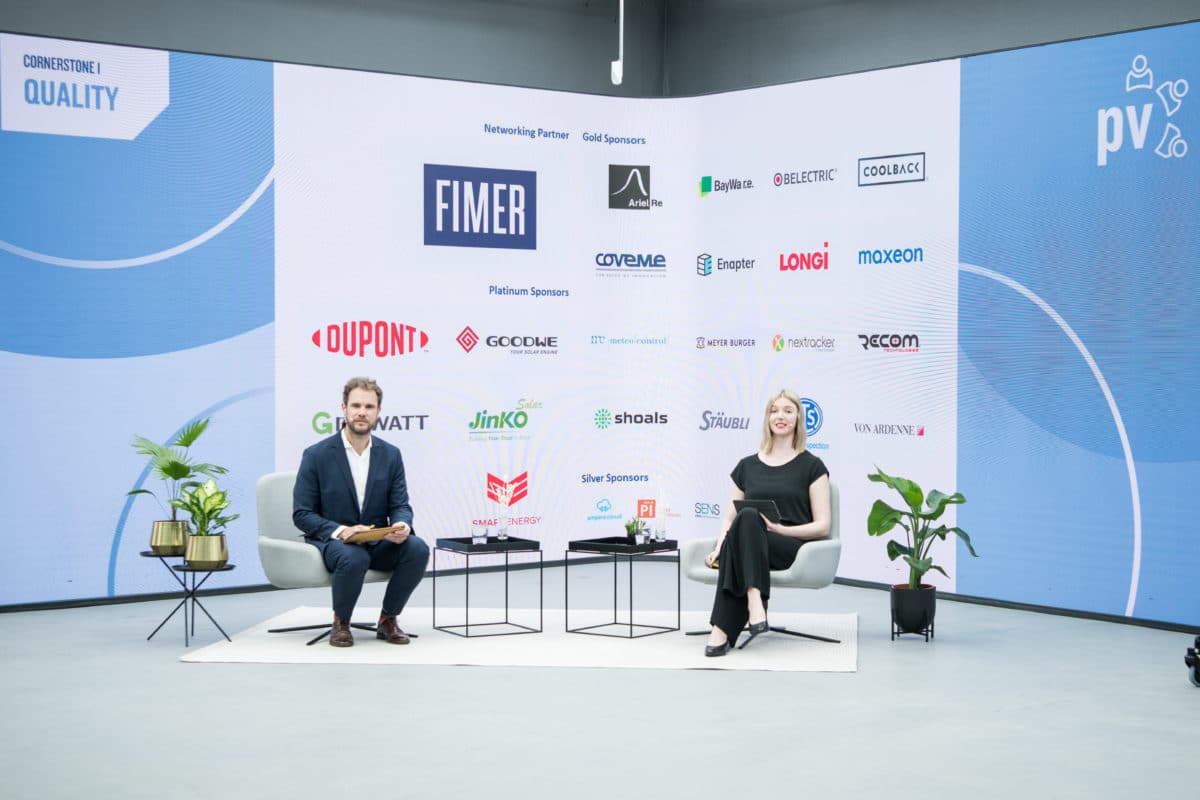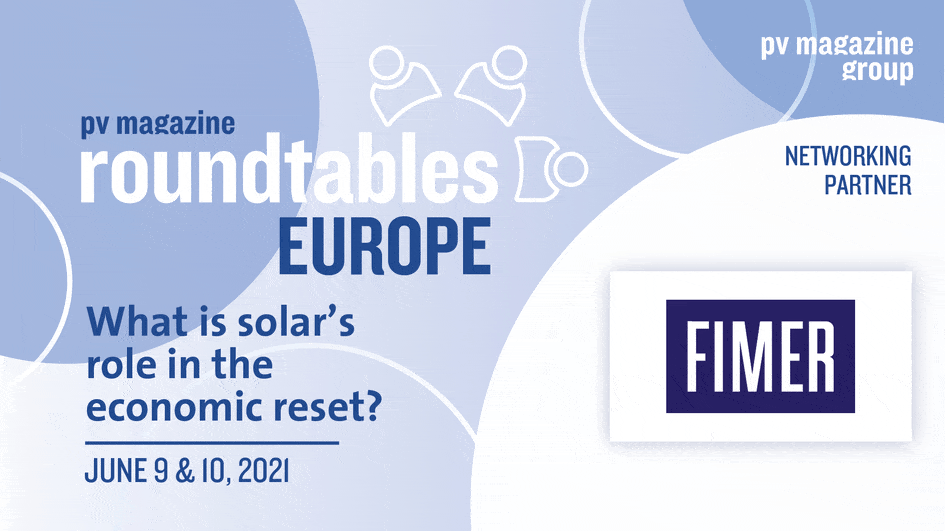
That's a wrap!
The 2021 pv magazine Roundtables Europe event is over. We would like to say a huge thank you to the over 1,500 attendees who took the time to tune in over the past two days from across the world.
We would also like to thank the many experts who contributed to the numerous panel discussions, interviews, fireside chats, presentations, and networking sessions, for creating an interesting and lively discussion on topics ranging from quality issues in large format PV modules, sustainable supply chains, asset management, and hydrogen innovation, among many others.
And of course, we would like to thank all of our sponsors for helping to make this event a reality!
If you missed any of the sessions, you can view all the presentations and discussions on pv magazine. And make sure you stay tuned for more information on our next events in the U.S. and Australia.
Finally, pv magazine would like to wish you all a wonderful rest of your day, and a fruitful collaboration going forward!
That's it for Cornerstone 4, the Innovation Hub has had its say
That's it for Cornerstone 4, pv magazine's European Roundtables Innovation Hub.
We are left optimistic that green hydrogen in Europe is key to reducing emissions in “difficult sectors”. And the staggering 1,000 GW of energy storage prophesied for Europe somehow, at the end of the panel discussion, seemed eminently achievable.
Of course, whether this optimism is well founded will depend upon the continuance of European innovation.
Vehicle to grid - customers are keen to plug in
Claire Miller, Director of Technology and Innovation at Octopus Electric Vehicles is running a trial to see whether electric vehicle owners are willing to use their EV battery to participate in the grid for a small payment.
Interestingly, Miller points out that modern trends spawned from the Covid-19 pandemic, such as a reduction in commuting. If more people are staying at home more often, that means there are more EVs plugged into the grid and available to participate.
But are the car manufacturers preparing for the challenge of vehicle to grid? Andreas Piepenbrink, Managing Director of Hager Energy said he could only speak for the German manufacturers, but that those at least are preparing a standard in order that all their EVs will be able to communicate with the grid within the next 36 months.
Miller concurred that the international standard was in a final draft stage. And that despite the great excitement about the potential of vehicle to grid, it is not until the standard becomes rule that the market can really begin to charge.
Can we achieve 1000 GW of storage?
The question is asked, can we really acheive the 1000 GW goal. The answer, from Andreas Piepenbrink, Managing Director of Hager Energy, is a definitive “Yes.” The reason being that we will be seeing 20-30 million electric vehicles and each of them with 50 kW means that not only will 1000 GW of storage be met in Europe, but easily achieved.

Why the U.S. is so far ahead when it comes to energy storage
Marta Victoria, Assistant Professor at Aarhus University returns to the fray for the final panel discussion. Victoria said that energy storage is best suited to solar PV but it is not restricted to solar PV, it has usage for hydrogen, wind, etc.
Victoria said that it is not surprising, given the advanced network of the European grid interconnection, and that is why we are not seeing huge capacities of energy storage installed in Europe. But Victoria stressed that after 2030 when emissions reductions will only be more pressurised, Europe will start to catch up to the kind of project sizes we are currently seeing in the U.S.
Jansen noted that the kind of 100 MW systems we are seeing in the U.S. are not batting an eyelid, but if something even half that size was proposed in Europe we'd all fall off our seats.
Holger Wolfschmidt, Market Applications Director at Fluence, noted that infrastructure is “perfect in Europe compared to other continents” and that means that the opportunity for energy storage is there even if it is not currently dominating the market.
Europe is a changing landscape of energy storage
Europe has been historically centered around Germany and the United Kingdom, with new markets only opening slowly, says Julian Jansen, Associate Director, Consulting – Clean Technology & Renewables, HIS Markit.
Jansen noted that France, Spain and Portugal are beginning to grow their energy storage markets but everyone has a lot of ground to make up on, at least when it comes to front-of-meter storage, the United States.
Jansen added that while promising things like green hydrogen are great, the glory of energy storage is in its short-duration capabilities.
Bigger is not always better, miniaturization is the new frontier for inverter innovation
Improvements in modular power electronics is pushing the market toward string inverters and decentralized systems.
Filippo Carzaniga, Chairman of the Board of FIMER Group, said miniaturization of inverters is a key frontier of innovation.
Digital capabilities are the other frontier. “We are introducing artificial intelligence in the highest level, and machine learning to improve maintenance.”
Carzaniga clarified that while inverters will be getting smaller, it will not negatively impact their ability to deal with the new trend of larger modules.
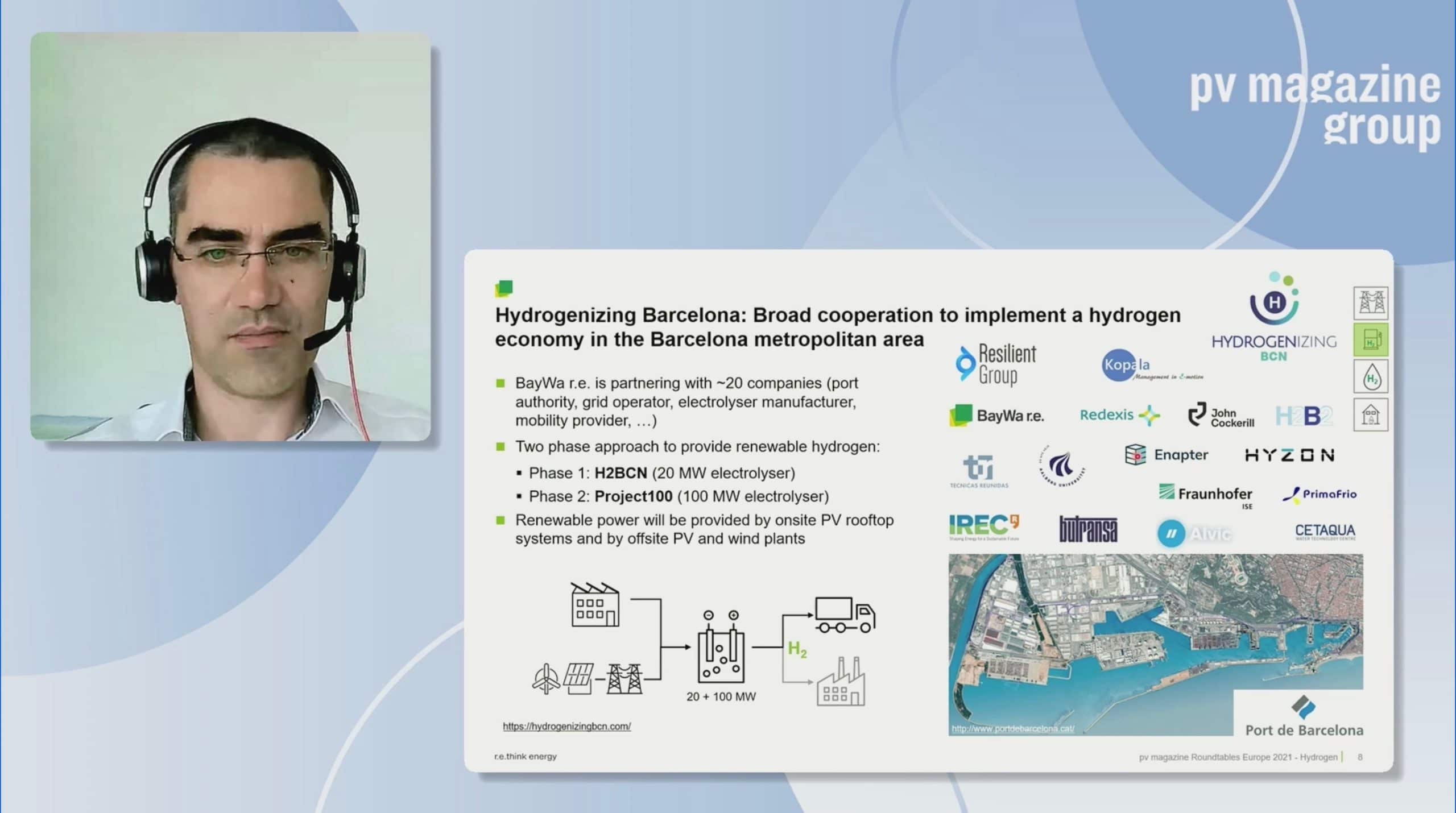
Hydrogenizing Barcelona is no Sagrada Familia, it'll happen rapidly
After over a century, Barcelona's Sagrada Familia is only finally nearing completion today. But “Hydrogenizing Barcelona” will not take anywhere near as long. Manfred Groh, Manager Hydrogen Projects, BayWa r.e. gave us a taste of a broad cooperation (over 20 companies) to implement a hydrogen economy in the Barcelona metropolitan area.
The project, to proceed in two phases, will see a 20 MW electrolyzer and a 100 MW electrolyzer fed by onsite rooftop solar PV and offsite PV and wind plants.
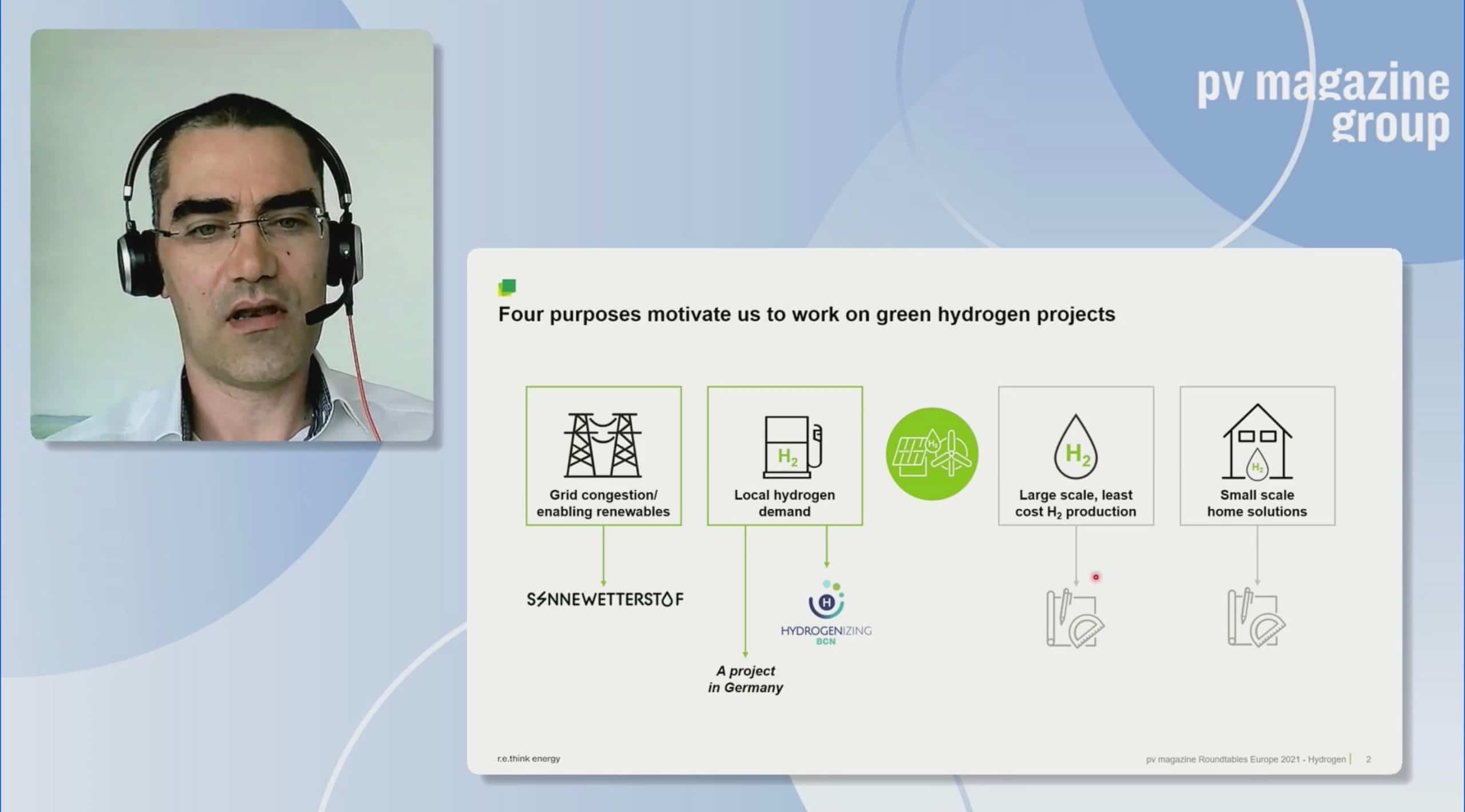
Grid congestion is a key motivation for green hydrogen
Manfred Groh, Manager Hydrogen Projects, BayWa r.e. begins a presentation about why a leading project developer and investor cannot wait to start hydrogen projects.
Groh notes that there are at least four main motivations for big developers toward hydrogen projects and they are:
- Grid congestion
- Local hydrogen demand
- Large scale project demand
- Small scale project demand
As far as grid congestion goes, Baywa r.e. and Dutch grid operator Alliander are commissioning a project for September/October 2021 in which 50 MWp of solar will be used to produce green hydrogen 40km southwest of Groningen. Of course, grid constraints in the Netherlands means that projects can wait a number of years before connection, making hydrogen production a much more interesting side-hustle.
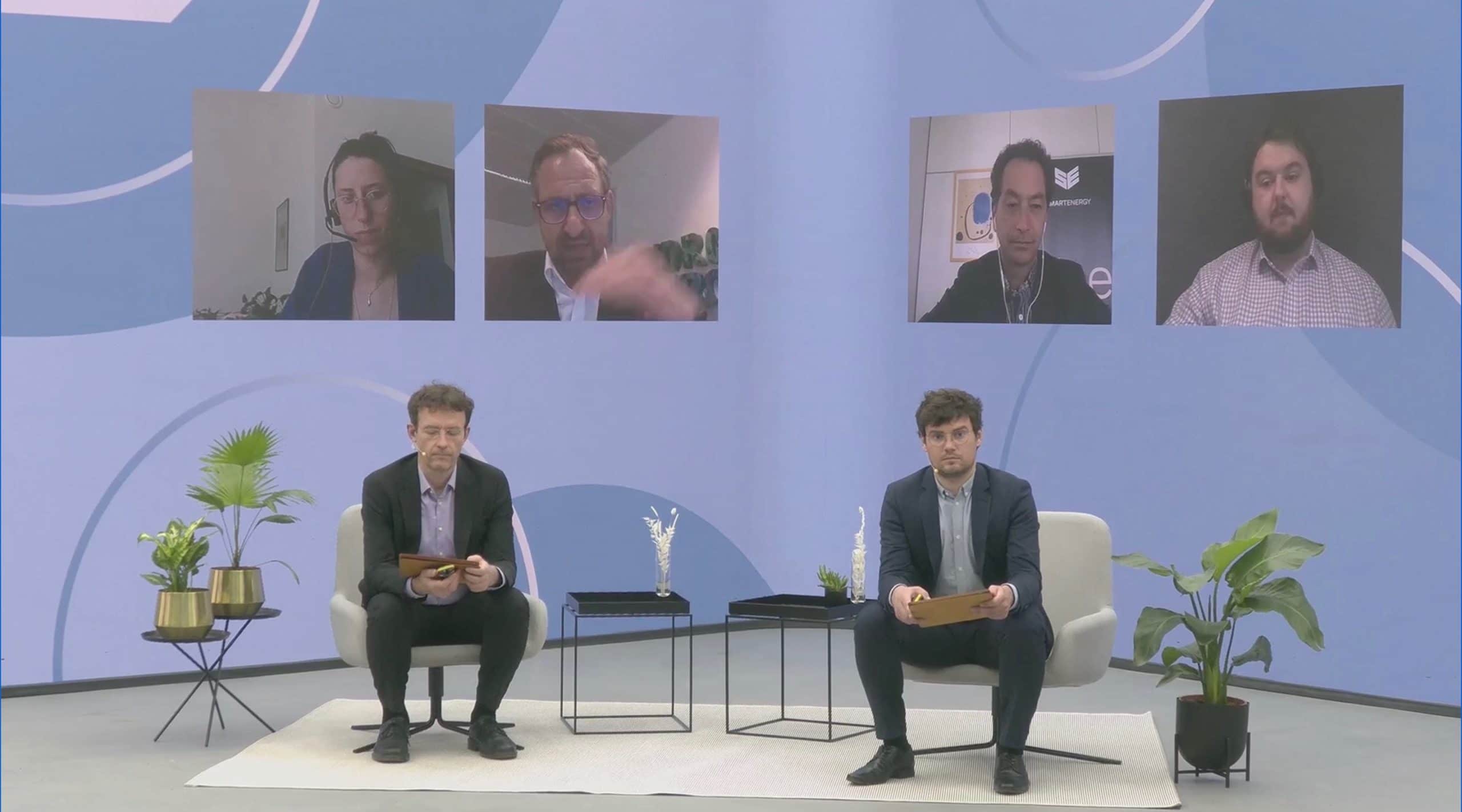
How efficient is solar to hydrogen?
What is the conversion efficiency at the moment for solar to hydrogen? Jan-Justus Schmidt, Co-founder Enapter says “We require about 50 kWh of effiency to produce 1kg of hydrogen.” He notes that this is a good efficiency for the moment, but points to several percentage points of improvement on the horizon.
Of course, these efficiency developments require scale and investment. Aurélie Beauvais, Deputy CEO SolarPower Europe, notes that the LCOH is determined by the LCOE and the capex of electrolyzers. for the latter, Beauvais said that Europe has to support large-scale electrolyzer factories across the continent.
We have not yet seen all the "killer applications" of which hydrogen is capable
Following on from a short presentation from Pasi Bainikka, CEO of Finnish firm Solar Foods, Jan-Justus Schmidt, Co-founder Enapter, says that we have not yet seen all the “killer applications” hydrogen is capable of.
Hydrogen is an element we have ignored for way too long, but not anymore. Innovators around the world are discovering the flexibility and variety of this the most abundant element in the universe.
"The best marriage in the renewable world is solar and hydrogen"
When pv magazine moderator Michael Fuhs asked Jorgo Chatzimarkakis, Secretary General of Hydrogen Europe, whether Europe was devoted to developing green hydrogen as opposed to hydrogen with emissions.
Chatzimarkakis noted that while technology paths in the future are open, Europe knows that “The best marriage in the renewable world is between solar and hydrogen.”
Chicken and egg is the crux of the problem
Aurélie Beauvais, Deputy CEO SolarPower Europe, noted that only 4% of hydrogen produced in Europe is renewable, and that renewable hydrogen remains less competitive than blue hydrogen. That, says Beauvais, is a big problem.
Nevertheless, there are various ways we are working to improve the situation:
- Firstly, says Beauais, we need support schemes at the production level and the operators of the electrolyzers.
- We need to develop the market, and that is why hard to electrify sectors need to be encouraged to take up more and more clean hydrogen.
- Certification systems – “how can we define and certify renewable hydrogen, and how can we make sure we are not double counting the electron that's produced?”
Forget Hindenburg, hydrogen is safe
An audience question comes in with concern to the safety of co-locating hydrogen and storage. Pho Duc says that the safety fears (lingering from Hindenburg) do not have great credence as the modern safety standards are much more organized and well-structured.
Electrolyzer technologies need projects now
Jan-Justus Schmidt, Co-founder Enapter, says that green hydrogen is essential to heating, transport, industry, and long term storage. He believes Enapter is rethinking electrolyzers as mass produced products, achieving low cost and accelerated emissions reduction. “Under 2 Euro a kilogram is absolutely possible…and the cost curve will be very similar to the pv industry.” Schmidt says.
Christian Pho Duc, CTO & Managing Director H2 Projects at Smartenergy, spoke to the variety of electrolyzer technologies fighting it out for supremacy at this pivotal moment. But stressed that the technologies need to be implemented in projects before we can see which technologies will rise to the top.
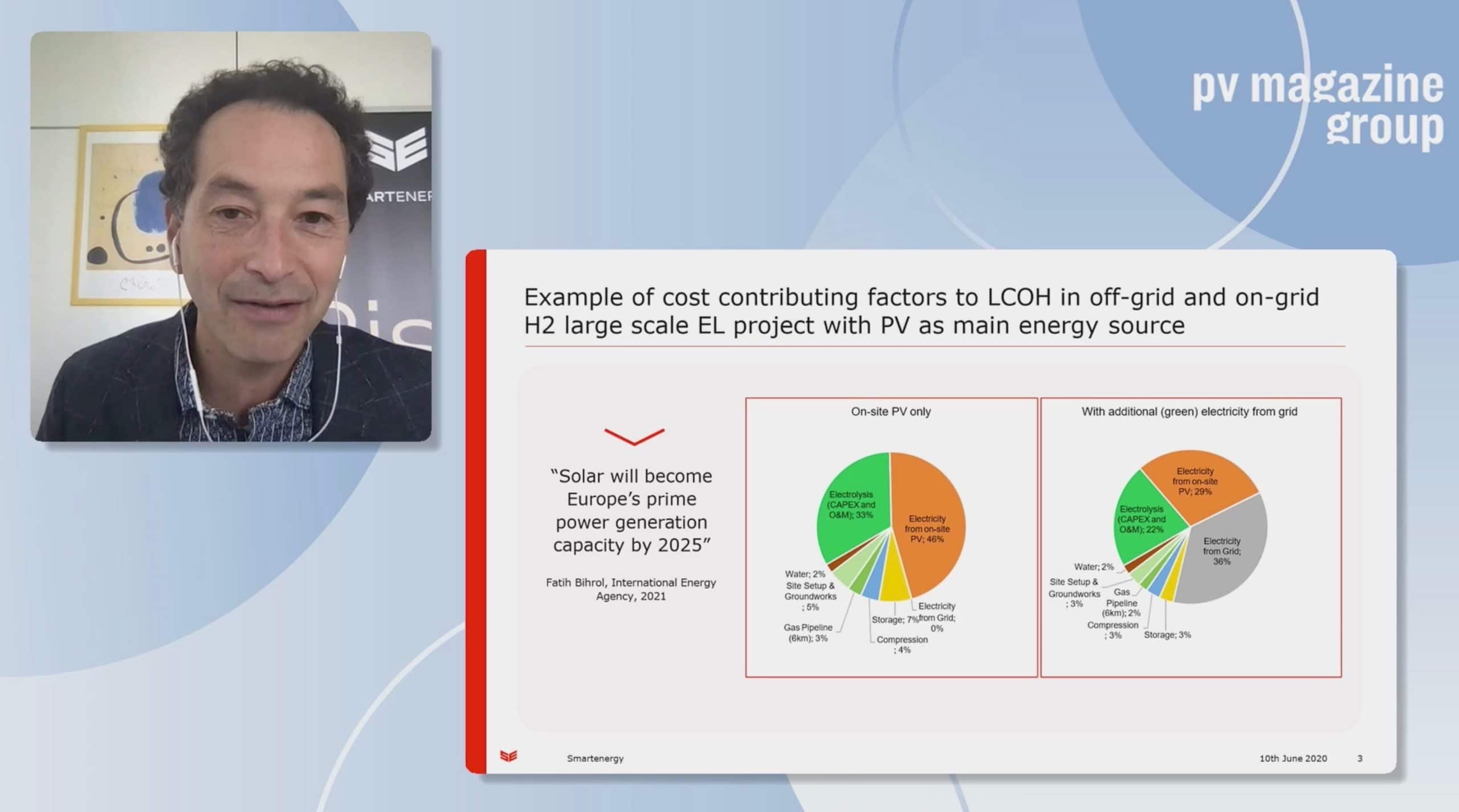
Solar and hydrogen together can win a lot
Faith Bihrol of the International Energy Agency has said that “Solar will become Europe's prime power generation capacity by 2025”, and this, says, Christian Pho Duc, CTO & Managing Director H2 Projects at Smartenergy, is the major driver behind the descending levelized cost of hydrogen (LCOH).
“Both together (solar and hydrogen) can win a lot,” continued Pho Duc, who advises solar developers to consider co-located hydrogen generation as a way to achieve “additionality”, which is to say a way of producing varied generation potential while also scaling green hydrogen to continue to bring costs down.
After all, one of the main challenges remains the cost of electrolyzers.
Hydrogen is key to cleaning "difficult sectors"
Assistant Professor at Aarhus University, Marta Victoria, gets the green hydrogen ball rolling. Victoria makes the point that we need more technologies than just solar and wind to make this energy transition stick.
Hydrogen is one of those technologies; it is one of, if not the best option for seasonal power storage. “We need 220 TW per year for this purpose,” says Victoria.
Of course, seasonal power storage is not the only, “difficult sector”, but it is in the “difficult sectors”, Victoria notes, that are where green hydrogen is most useful and most needed.
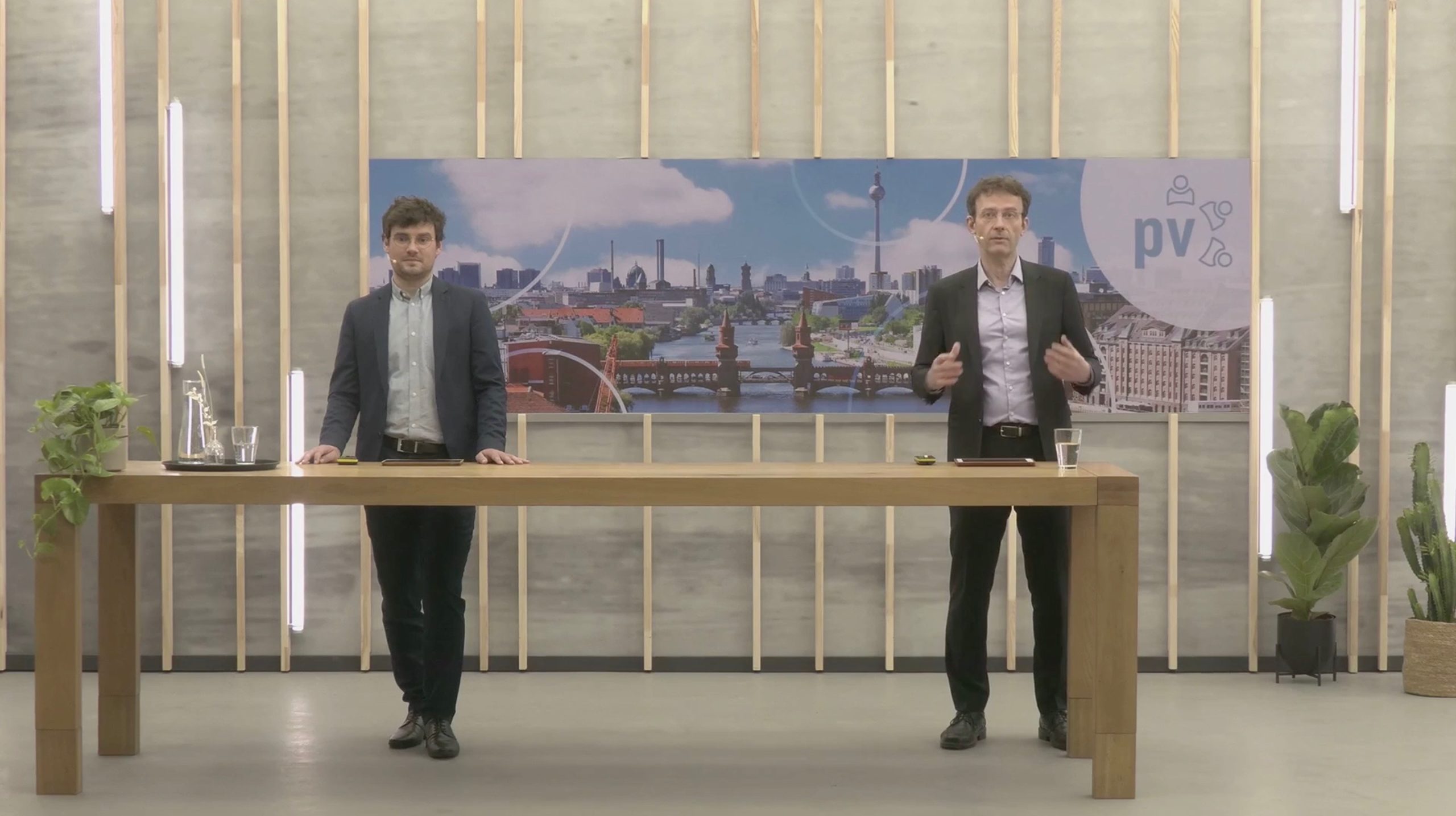
Welcome to the Innovation Hub - hydrogen, battery storage, and e-mobility raise new opportunities for solar companies
On your marks, get set, Innovate! We're live with our fourth and last cornerstone for Roundtables Europe.
pv magazine moderators Michael Fuhs and Marian Willuhn are about to take us into a closer look at the world beyond solar, into the realm of innovation, and perhaps the most talked about realm in innovation at the minute is green hydrogen, and that is where we're starting.
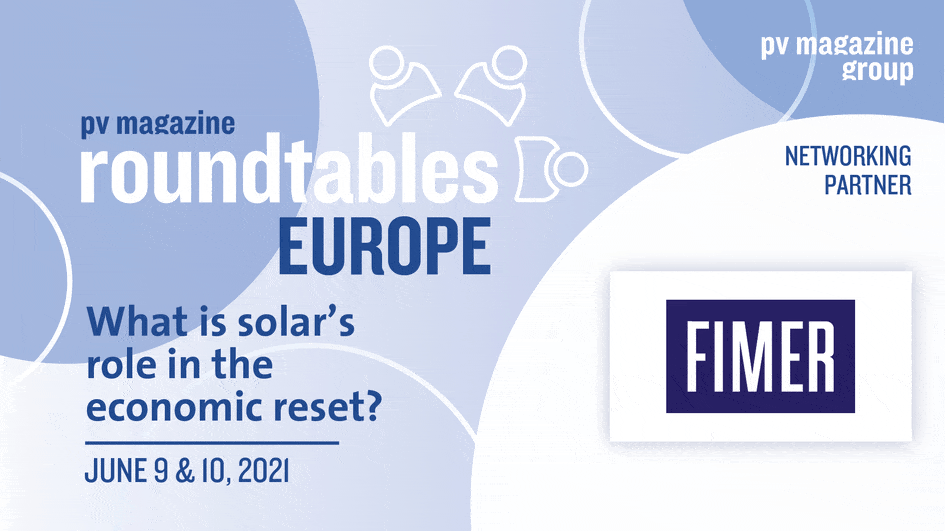
Time for lunch!
The first Cornerstone on Sustainability and Made in Europe is over. We heard from a range of experts on diverse subjects including circular manufacturing and closed loop recycling, the opportunities and challenges of European PV manufacturing, and perspectives from outside the solar industry.
As with all our cornerstones, the presentations and recordings of the speakers will be available online shortly.
Coming up at 2 p.m. CEST is our final cornerstone: The innovation hub – hydrogen, battery storage, and e-mobility raise new opportunities for solar companies. Here you will discover which innovations, technological or regulatory, are necessary to compete, and how and when can the market become as attractive for solar companies across the continent as it is for their U.S. counterparts.
Register for the Roundtables for free. Already signed up? Access the pv magazine Roundtables Europe event platform.
Overall, we've had 1,500 attendees from across the globe tuning in to hear our expert speakers share their thoughts. Coverage from day 1 is available, and we will also be live blogging this afternoon, so stay tuned!
If you've enjoyed the Roundtables thus far, make sure you stay tuned for details on our upcoming events in the U.S. and Australia, which will be published soon.
Where's the fire?
Good morning Roundtablers,
We're now ready for a fireside chat with Lubomila Jordanova, co-founder and CEO of Berlin start-up PlanA, which helps corporates measure and report their environmental, social and governance performance.
Jordanova will be talking about how working with material and component suppliers can deliver sustainability wins. If you missed the discussion, a recording will be uploaded to our website later today.
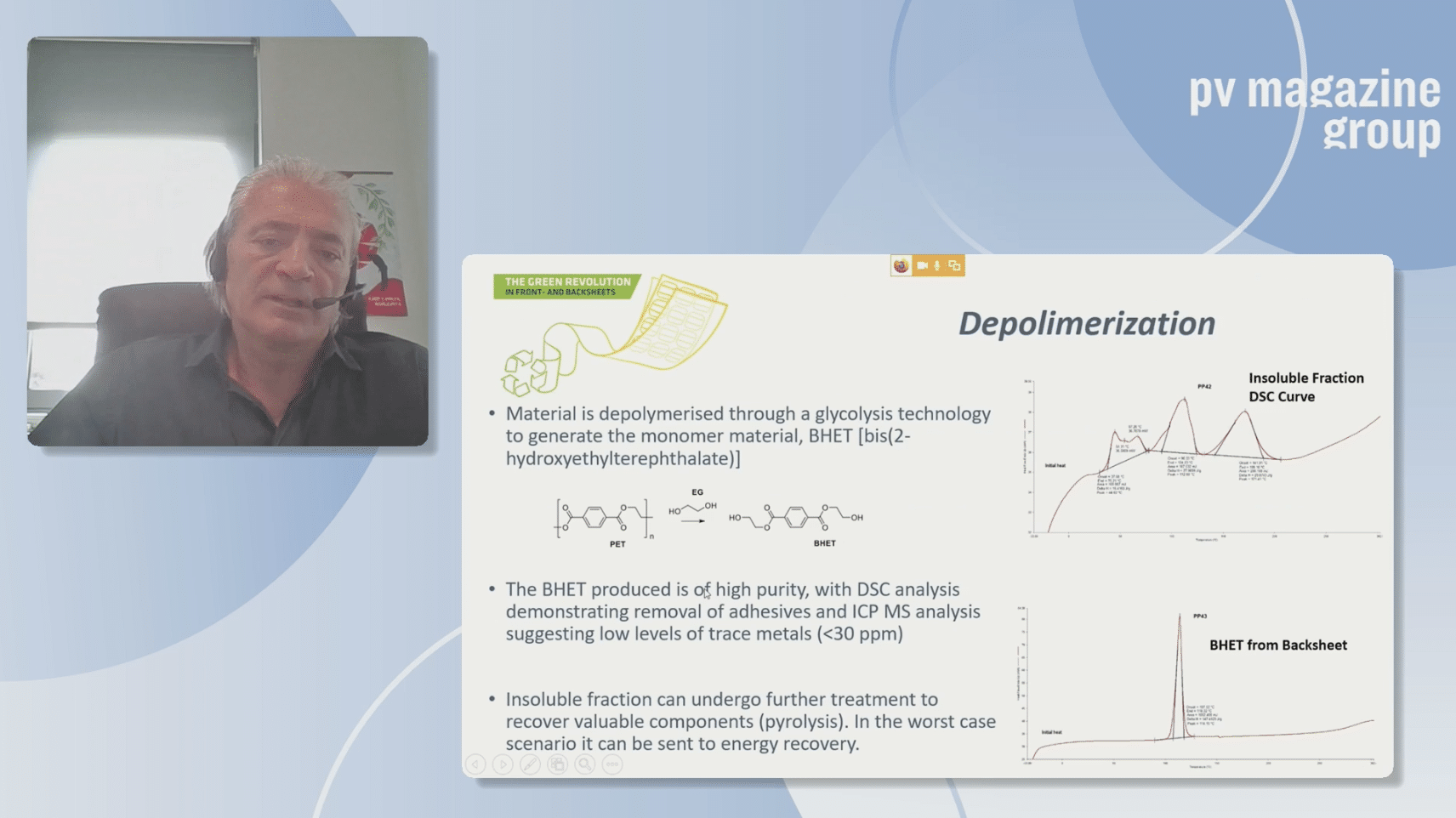
Circular economy for key PV module materials
Sustainability and the pursuit of the circular economy could deliver a competitive advantage for EU solar manufacturing – and clear the way for governmental support. Michele Vannini, business manager of Coveme presented the company's innovative project that aims for truly circular PV materials.
Specifically, he discussed a closed loop recycling system for PV backsheets, and how to recover the polyester for re-use without compromising performance. Coveme worked with DuPont Teijin, both of which are partners to pv magazine's UP sustainability initiative, to research the process.
The presentation and a recording of his talk, will be available soon.
Last year, the UP initiative focused on circular manufacturing. Read our coverage from the quarter.
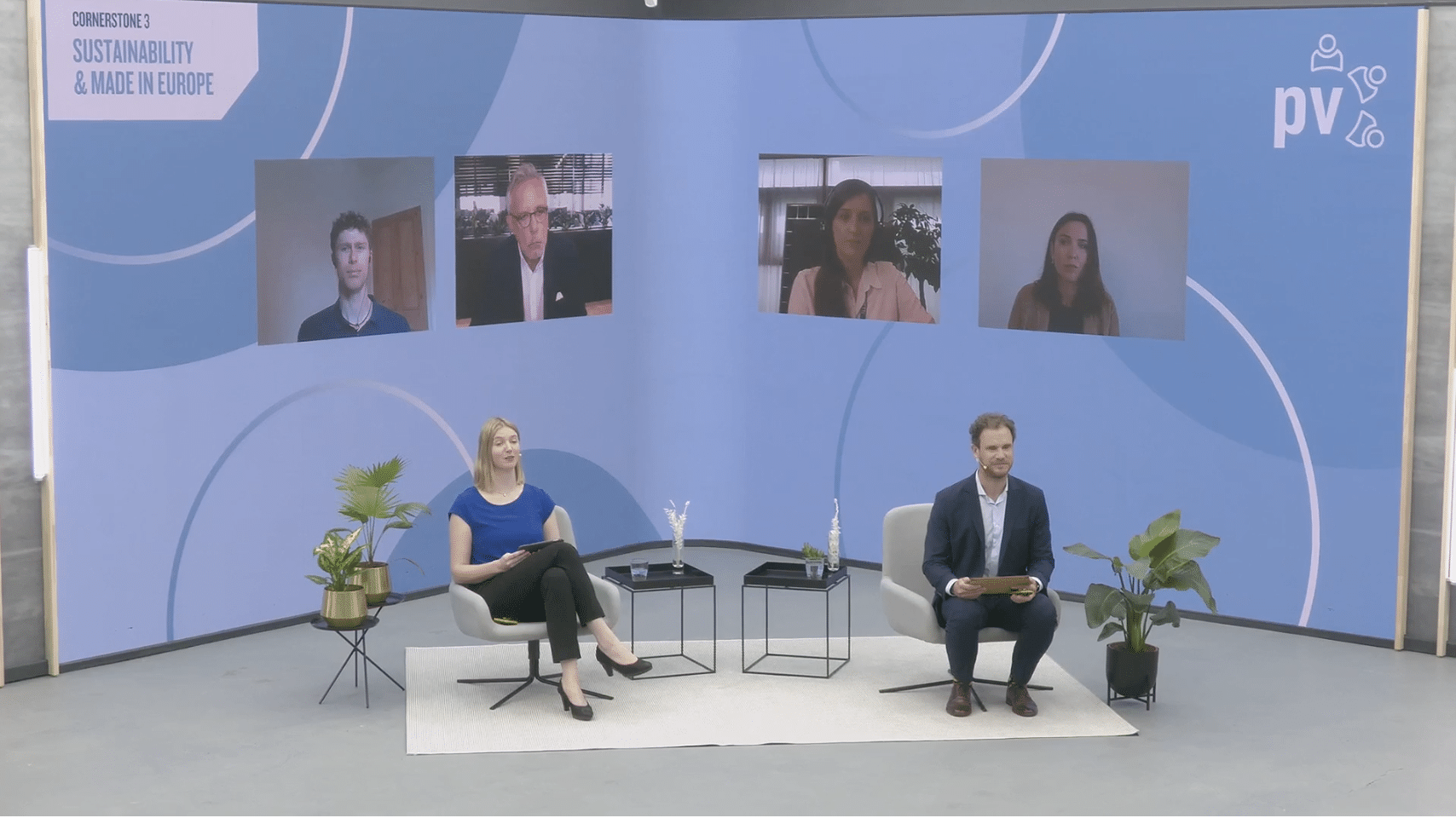
How can Made in Europe PV production be competitive?
If the European solar industry is to re-establish manufacturing at scale, what technologies, support measures, and strategies could potentially deliver success?
Our panel, comprising Alex Barrows, director of research at Exawatt, Laura Sartore CEO of Ecoprogetti, Edurne Zoco executive director of clean energy at IHS Markit, and Vartan Oskanian advisor to the CEO of Recom, discussed these key issues.
Alex Barrows said that there is currently around 10 GW of PV module manufacturing capacity located in Europe, if you include Turkey, although some of it is underutilized.
He added that Europe is good at focusing on the two ends of supply chain, for example, Wacker Chemie and polysilicon production, and module manufacturers of which there are a number of small companies operating in Europe. What is missing is the middle of the supply chain, i.e. the manufacture of wafers and cells, of which there is just 1-2 GW of capacity.
Edurne Zoco said that there a a few different factors which have helped the current EU-based module manufacturers to be successful, including the presence of local content or carbon footprint requirements for solar projects. The double digit growth of the installation market is also helping boost the landscape, as is module technology differentiation.
Laura Sartore, meanwhile, believes that European manufacturers' level of customized automation and automation that is integrated with logistics, have helped establish their businesses.
Flexibility also plays a key role, she said, with successful manufacturers managing to adjust their production lines to specific kind of modules for specific markets , e.g. rooftops in Italy, Hungary, or Germany.
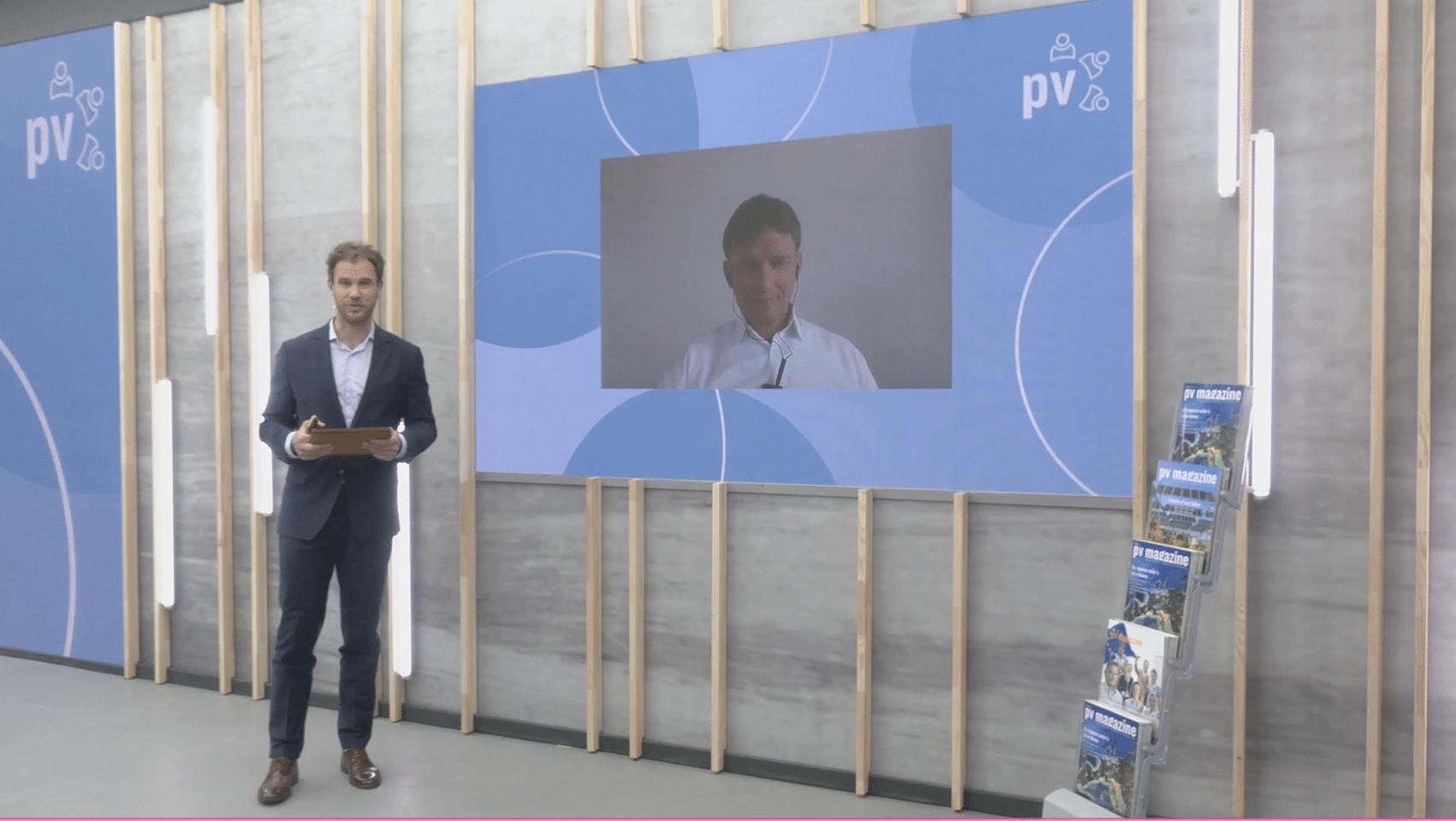
European PV manufacturing ambition made real
Former production equipment supplier Meyer Burger is pursuing the bold plan for German HJT cell and PV module manufacturing. Gunter Erfurt, CEO, Meyer Burger has outlined the Swiss company's next steps and what can be done to support the initiative-seizing endeavor.
Erfurt said that Meyer Burger currently has a “very small” manufacturing capacity of 400 MW. However, the goal is to “grow as fast as we can” to become a multi-GW player. The next phase targets 1.4 GW by the end of 2023, and should approach 5 GW by end of 2026.
The PV modules are sustainable, said Erfurt, in terms of the recycling process, which employs a circular approach and reuses 98% of components. They are also lead-free.
He added that it is important to understand that the solar supply chain has been optimized over the past decade. Thus, further cost reductions will be associated with technological improvements, like higher efficiencies, thinner wafers, and removing silver, for instance.
Furthermore, it is important to move away from a focus on $/Wp. The levelized cost of electricity (LCOE) is what matters, he said, with energy yields a key issue. “We are focusing on this,” he said, explaining that Meyer Burger is already working on the next generation of HJT. Already the company has tested module efficiencies “way above” 24%, he said.
Overall, he believes the question is not ‘should a European-only manufacturing landscape be established?'. Europe should not create an isolated market, he said, but rather form part of the global industry.

Is there a case for EU solar manufacturing?
In a panel on the rationale for Made in Europe PV, we heard the panelists discussing the recent price hikes in solar raw materials and logistics, which have “significantly” increased over the past few months due to the Covid-19 pandemic, among other factors.
Naomi Chevillard, senior policy advisor, SolarPower Europe, believes these increases make the case for the development of a European PV manufacturing industry. However, she says they are not the only driver. There are also opportunities in the heterojunction (HJT) technology, for instance, that Meyer Burger is working on.
Jenny Chase, head of solar analysis at BloombergNEF, disagrees. Stating that a European manufacturing market will always remain a “cottage industry”.
She added that even if we had solar manufacturing bases in Europe, we would still have experienced price increases. “There's a global economic upswing that’s driving commodity prices up,” she said, and also a perceived polysilicon problem, which BNEF is not convinced actually exists. Furthermore, she believes a China-free supply chain is unrealistic, given the fact China is a leading manufacturer of ingots and wafers.
Dangers facing the European Green Deal
The EU Green Deal looks to be a sweeping range of policy measures that could present considerable opportunities for solar. But can they extend to manufacturing? And what details from the plan are emerging?
Sven Giegold, MEP, from North-Rhine-Westphalia / Germany, a spokesperson for the German Greens in the European parliament and coordinator of the Greens/EFA group in the ECON (economy and monetary affairs) committee, is joining us live to discuss.

Day 2 kicks off
The first day of the pv magazine Roundtables Europe has successfully wrapped, with over 1,000 people tuning in from around the world to listen to our expert panels talk about large PV module formats and the associated quality risks, and asset management, with a particular focus on ESG. Check out our live blog from Day 1.
Coming up this morning, we have a number of Networking and Meet the Speaker sessions, in addition to the final two cornerstone panels on Sustainability and Made in Europe; and the Innovation Hub: Hydrogen, battery storage, and e-mobility.
Enjoy!
